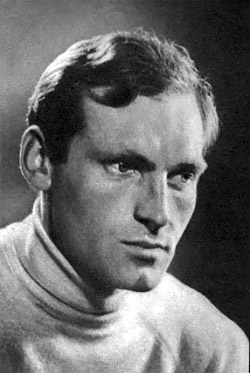
Electronic english version since 2022 |
The newspaper was founded in November 1957
| |
I want to know everything!
The fate of a book and its author
In the popular scientific literature published in the Soviet Union, there are books by the authors from Dubna. The brochure "Transuranic elements" by V.I.Kuznetsov, published in the series "Znanie", the books "On the way to superelements" by G.N.Flerov and A.S.Ilinov, "New professions of heavy ions" by V.S.Barashenkov, "The universe of particles" by G.L.Vardenga and E.O.Okonov, "Temperature" and other books and brochures by Ya.A.Smorodinsky, "The Birth of the peaceful atom" by D.I.Blokhintsev are still kept on the shelves of the home libraries of their first readers.
The age of the most popular science books is short. But sometimes, they outlive their authors and some remain for centuries. For example, the work "On the nature of things" by Titus Lucretius Cara, through which in the Renaissance scientists and philosophers learnt about ancient atomism. Kepler's touching treatise "On hexagonal snowflakes", Camille Flammarion's "History of the sky" that is no longer so far from us and Matvei Bronstein's "Solar matter" that was reissued a few years ago and is the same age as our fathers and grandfathers, have also stood the test of time.
In 2015, a reprint of the book by D.I.Blokhintsev and S.I.Drabkina "A.Einstein's theory of relativity", written back in the 1930s was published in the column "Masterpieces of popular science literature"; in 2008, "Temperature" by Ya.A.Smorodinsky was republished. Let us dwell on three books by the authors from Dubna.
For a physicist, the history of his science is an essential component of education,
without which he risks remaining a craftsman.
L.I.Ponomarev
 Leonid Ivanovich Ponomarev's book "Under the sign of the quantum", first published in 1971 under the title "On the other side of the quantum", has been reprinted several times since then and is still read as a romantic, with a slight detective bias, tale of human thought. In 2012, the book's author would say, "I've been writing it for 40 years. At first, it was a small book, it appeared as a spontaneous reaction of a neophyte to the beauty of the quantum world opened to him. Many years later, I returned to it with a conscious intention to write a modern natural-scientific picture of the world, the basis of which is the doctrine of quanta...".
Leonid Ivanovich Ponomarev's book "Under the sign of the quantum", first published in 1971 under the title "On the other side of the quantum", has been reprinted several times since then and is still read as a romantic, with a slight detective bias, tale of human thought. In 2012, the book's author would say, "I've been writing it for 40 years. At first, it was a small book, it appeared as a spontaneous reaction of a neophyte to the beauty of the quantum world opened to him. Many years later, I returned to it with a conscious intention to write a modern natural-scientific picture of the world, the basis of which is the doctrine of quanta...".
The author tells about the life of remarkable ideas that are hundreds and some of them thousands of years old, about the discreteness of matter, about atoms of electricity and about what physicists have finally come to - the modern bricks of the universe: about leptons that still look like particles, if we don't mention neutrinos and about quarks that with their properties resemble not Democritus' atoms, but Aristotle's elements. Seeing and understanding... "Could Fraunhofer that noticed the splitting of the D-line of sodium, have suspected that he held the key to quantum mechanics?"
 This book is also about human passions, disappointments and hopes, inspirations and feelings of hopelessness, the invariable companions of the knowledge of nature. Here is how, for example, Werner Heisenberg marked the peak of his creativity. It happened in the summer of 1925. It was three o'clock in the morning when he finished his calculations. Going to bed was out of the question, he recalled; he climbed to the top of a lonely rock and met the dawn ...
This book is also about human passions, disappointments and hopes, inspirations and feelings of hopelessness, the invariable companions of the knowledge of nature. Here is how, for example, Werner Heisenberg marked the peak of his creativity. It happened in the summer of 1925. It was three o'clock in the morning when he finished his calculations. Going to bed was out of the question, he recalled; he climbed to the top of a lonely rock and met the dawn ...
The fourth edition of the book - it is already 2012. Another era and other moods. In the USSR, popularization of scientific knowledge was a task of state importance. As Andrey Vaganov writes in his book "The Genre we lost", every twentieth book published in the 1980s belonged to the section "Popular science literature" and the circulation of the magazine "Science and life" exceeded 3 million copies. In the Russian Federation, from the very beginning, science was separated from the state and popularization of scientific knowledge became the business of science itself. And the state? In a conversation with science journalist Vladimir Gubarev, Academician Ponomarev quoted the words of his colleague N.N.Moiseev: "Previously, the government was uneducated, but it knew it. Therefore, when difficult issues arose, they turned to us. But the present authorities think that they know everything". And then he continued to share his thoughts. "Science, as we know, stands on the shoulders of titans." "And politics?" asked the journalist. "Politics stands on the shoulders of pygmies. Isn't that a bit harsh? Politicians often repeat the mistakes of their predecessors, they do not think about the future. They only care about tomorrow, while scientists think in terms of centuries."

And now, about the author of the book. He lived and worked in Dubna for 20 years, the old-timers remember him and his colleagues still work in BLTP. But people who have never seen him have already grown up and become strong in science and it would be necessary to say a few words about him. Here is what Leonid Ivanovich told about himself (from interviews of different years, in abbreviations):
"I am from Donbass, from the small working-class village of Druzhkovka. When I was 12 years old, my father took me to the factory library, where I helped to issue books, glue library forms; I still remember the smell of typographical glue that came with a batch of new books... Almost every day I went there after school (I was already 14-15 years old) and sat there for hours, carefully leafing through the pages covered with tissue paper. And then there was a fascination with astronomy under the black Ukrainian sky, a poetic description of which I later found in Chekhov's "Stepi"... I remember me in the 8th (!) grade to be assigned to make a report on the electronic structure of lanthanides... When I finished school, I had no doubts about my choice of path and there were no class barriers on this path at that time, even for a boy from a worker's village. I came to Moscow, took a guidebook on universities. I found the Department of Physics and Chemistry at Mendeleevka. Clearly, there would be Maths at that Department, too...
We had a unique group: future academicians Legasov and Myasoedov, brilliant engineers - future heads of nuclear industry enterprises... In the third year, I decided to change my university. It happened for many reasons and not a small role was played by Dirac's lecture that he gave in the Polytechnic Museum. The famous physicist spoke brilliantly! Then, I went to the lectures of Professor Smorodinsky, of our other scientists...
They didn't want to let me go, I was a Stalin scholarship holder in "Mendeleevka", but I achieved my goal - I entered the Physics Faculty of Moscow State University. I was assigned to Dubna and worked there for 20 years. And afterwards, I went to the Kurchatov Institute...".
The work on mu-catalysis brought Leonid Ivanovich worldwide fame. A tempting opportunity to obtain a controlled nuclear fusion reaction without millions of degrees, without problems with plasma instabilities in the magnetic field that have been fought since the 1950s in attempts to master thermonuclear energy for peaceful purposes... opened up. In the late 1980s, Leonid Ivanovich was still optimistic:
"If the muon were only 1 per cent heavier, there would be nothing to talk about. If the muon were only 1 per cent lighter, the issue of the practical use of the phenomenon would also be meaningless. It reminds me of the situation with nuclear energy. If the neutron multiplication factor were only 10% less, a uranium-graphite reactor using natural uranium would be impossible and the entire history of the world's energy industry would follow a different path... At the sight of so many such happy coincidences, one does not want to think that their harmonious combination that is the essence of muon catalysis, is just a beautiful but useless accident... As my friend and colleague G.Fiorentini said, "Se son rose fioriranno: if they are roses, they will bloom".
But let's go back to the book. Here are the reviews of grateful readers from various internet websites.
Vasastrodj: "The most interesting thing in popular science books is when you get to the point where the author describes, as in a breathtaking blockbuster, the application by people of all that scientists have done year after year of their lives, from the seemingly rather boring side... A vivid example of such a book is Leonid Ivanovich Ponomarev's "Under the sign of the quantum".
The old man: "In my opinion, this is the best popular book about modern physics. The man that created it, very subtly feels and understands what he writes about. And what musicality, play of thought! It has been on my bookshelf for at least 15 years. By profession I am a physics teacher at a secondary school. By "primary" education - "from the department of nuclear physics". Thank you for your labour."
Dvstula: "I have been using L.I.Ponomarev's book for 10 years in physics lessons in high school. Every year, I reread it and I never get tired of admiring it (the book is already falling apart). A lot of information for thinking. I think, it's one of the most magnificent books of our time. Low bow to the author."
MAYOROV47: "The book is wonderful; I teach physics to my grandson by this book."
Dmitry Anshakov: "It is one of my favourite popular science books during my school years, written in a simple, accessible and very, very entertaining way. And at the same time, it is flawless on the scientific side. Reading it, you're immersed in the atmosphere of scientific enquiry in the early 20th century together with Bohr, Rutherford, Heisenberg and other participants of those events you dig out from Nature its secrets..."
Ollandr: "It is an absolute masterpiece of popular science literature. I want to turn to it constantly, to look through it and again and again to find myself inside this exciting and intense history of ideas, discoveries and human destinies - quantum physics."
Caotica_Ana: "This book is the best I have read on quantum physics. It is written in a very clear and at the same time figurative language, there are quite a lot of formulae given, but they are all explained in detail. So I was finally able to understand the concepts of the tunnelling effect and the effective reaction cross-section... After reading this book I was left with a feeling of beauty and majesty of nature, of touching something infinite".
Ira: "What a marvellous book. Everything is laid out on the shelves. So vividly written! Like a detective story. Each chapter ends in such a way that you want to start reading the next one. The first evening "finished" to two in the morning. But I also realized that if I had not read Bodanis, Kaku, Gardner and most importantly, Weinberg before this book, it would have been rather tight. Thank you to the author! Many thanks!!! The book will stay in my home library. And I think, for very many years."
And only one voice falls out of the general chorus of praise.
D@perfilyev.ru: "Try to give this book to a pupil without prior training and let him, having read it from the beginning to the chapter "Spectrum" explain why, in the Kirchhoff-Bunsen experiment, when sunlight or light from a glowing body passes through a burner flame that gives a bright D-line, the D-line of the original light becomes darker. Based on the book data alone, it is impossible to explain this phenomenon... If you want to read something popular science without going into detail, then maybe the book is for you. It is impossible to understand something specific without involving knowledgeable people or other books."
And it already sounds like an invitation to a discussion about what popular science literature should be. Read about how the author of the book "Just kinematics" G.I.Kopylov approached the popularisation of scientific knowledge in one of the next issues of our weekly.
Alexandr RASTORGUEV
The first photo of L.I.Ponomarev is from the internet portal ras.ru (2017), the second photo is from the cover of the book published in 1971.